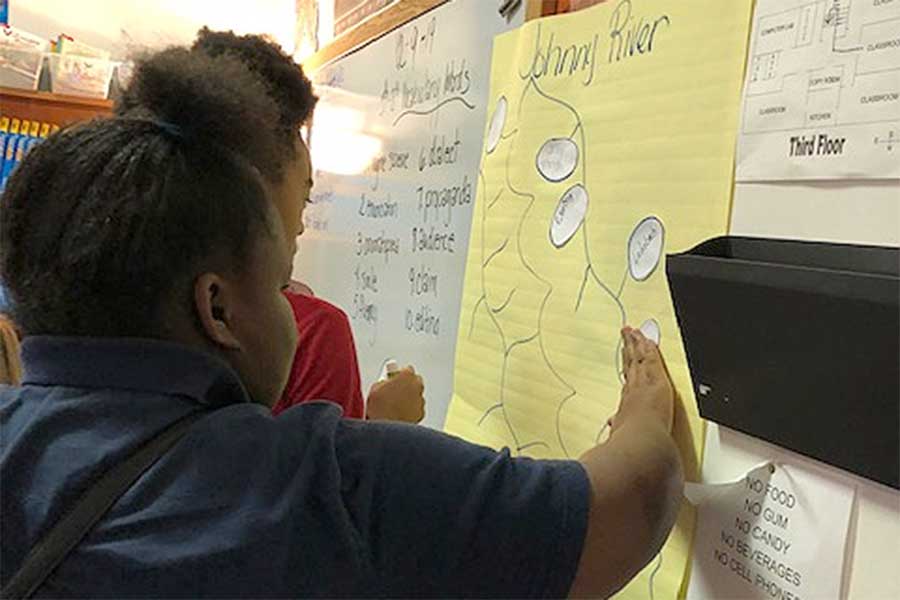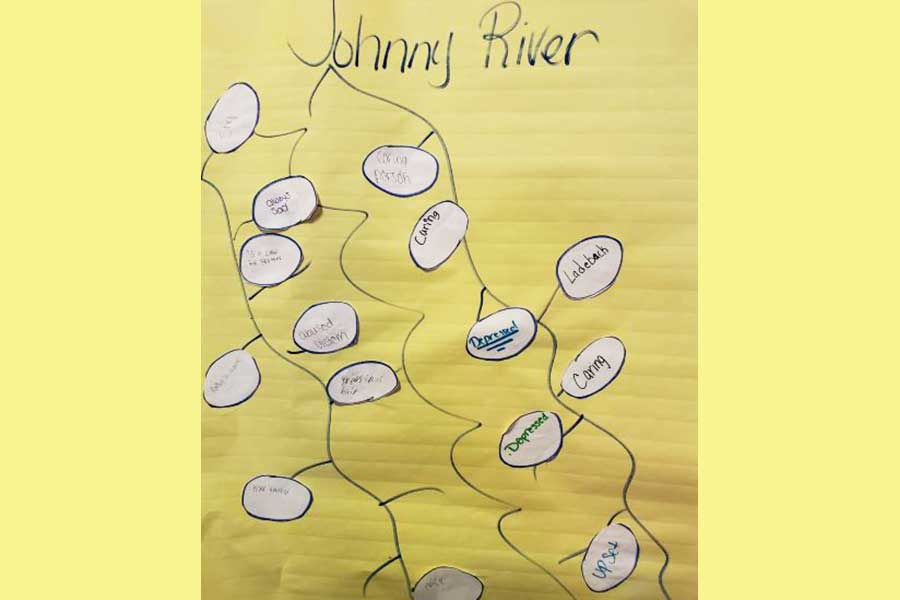A Flowing River with Evidence (S.E. Hinton’s “The Outsiders”)
Muse Machine 2019 Summer Institute-Inspired Lesson Plan
Developed by Nicole Askew
City Day Community School, Dayton, OH
Reading
Grade Level: Middle School
Lesson Plan Summary
Most middle school-age children struggle with issues around identity. They want peer recognition and approval and are watching their own bodies and emotions evolve. Caring adults who work with these young people try to provide tools to aid in this transformation to adulthood. Nicole Askew, teacher at City Day Community School, created an imaginative lesson to address this issue, while incorporating Ohio standards for language arts. Nicole skillfully interlaces character traits from the novel “The Outsiders” by S.E. Hinton into a group activity that she learned during 2019 Muse Machine Summer Institute. Using the device called “river stories,” presented by Ping Chong + Company artists, Nicole helps students portray the novel’s character traits in a group activity that is enjoyable and insightful. This is a lesson that is both creative and relevant for use by any middle school teacher.
Printable Lesson PlanOverview
Summary: In this lesson, students will collaborate with their peers to answer questions about a passage by citing textual evidence. They will then refer to the novel “The Outsiders” to write textual evidence of some of the characters on a “stone” and place it on the paper river. Students will also explain the reasoning behind their choice. They will then take that evidence and, as a class, create a River Story.
Standards:
- 7.RL.1 Cite several pieces of textual evidence to support analysis of what the text says explicitly as well as inferences drawn.
- 7.RL.3 Analyze how particular elements of a story or drama interact (e.g., how setting shapes the characters or plot.)
Objectives/Outcomes:
- Students will be able to analyze a text.
- Students will cite specific textual evidence to support analysis of literary text as well as support for inferences.
- Students will be able to identify and analyze character traits.
- Teaching Approach: Whole group & small group instruction
Assessment:
- Oral (Student responses of text evidence)
- Written (river stones of evidence)
- Character sketch based on evidence (river story)

Lesson Preparation
Teacher Needs:
- The Outsiders” by S.E. Hinton – Students should have the first four or five chapters read prior to this lesson.
- Three sheets of chart paper – Draw a river on each one and label one heading: Ponyboy, another one: Johnny and the third one: Dally
- Teacher-created small pieces of paper shaped like stones – provide each student with three stones
- Selections from “Who Is Tom?” [Click Here]
- “My Shadow” poem by Robert Louis Stevenson [Click Here]
- Character Sketch – the adjectives list may help students create better character descriptions [Click Here]
Helpful Hints: Showing students samples and creating a few “stones” together helps to make the directions clearer. The teacher should also be aware of information about students’ backgrounds and a sensitivity to their need for privacy in certain situations.
Student Needs:
- Prior Knowledge: Students will have been previously introduced to identifying main ideas and supporting details that will assist with providing textual evidence. Students will also be familiar with most of the characters in the novel prior to this lesson. Students have written stories before; however, this is an introduction to River Stories.
- Student Voice: Students can work with peers of their own choosing.
- Vocabulary: Main idea, details, textual evidence, character traits, character sketch, analyze
Evidence / Assessment of Outcomes
Students will create a brief character sketch (one to two paragraphs) about one of the three characters mentioned in this lesson based on the evidence they provided on the river stones.
Enduring Understandings
Students will understand that citing specific textual evidence adds necessary information and credibility to the analysis of a text.

Learning Plan
Prompt: I will ask students the following question: How can you tell that I am a reading teacher? (They may respond by pointing out some of the items they see around the room, posters, books, things we’ve done in class, etc.)
Hook: Teacher will display and read aloud the first stanza of “My Shadow” by Robert Louis Stevenson to the class (dramatically or in some other voice).
Essential Questions: How do you define evidence? What do you think of when you think about evidence? How do the traumatic events in one’s life shape behaviors?
Teacher and Student Performance Tasks:
Warm-Up: Project/display “My Shadow” by Robert Louis Stevenson and refer to the first stanza. Ask students to cite evidence that Stevenson is talking about his shadow (very, very like me, jumps before me when I jump into my bed).
Guided Practice: Ask students what the word evidence means (ex. obvious, a thing or things helpful in forming a conclusion or judgment, a sign). Ask students what they think of when they think about evidence (ex. evidence submitted in a court to prove a case). Explain that writers include evidence in their stories to help the reader understand the characters and the events happening in the story.
Project/display page 1 of “Who is Tom?” and read the text aloud. Ask students to characterize Tom (ex. he is forgetful). Ask students why he is forgetful. Students may say the text doesn’t allow for inference. Then display page 2 of “Who is Tom?” and read the text aloud. Ask students why Tom is forgetful. (ex. Mom was too busy to wake him up in time to get ready for school. Tom may be stressed because of twin babies in the house, dad working long hours, etc.) Point out that the author gives plenty of textual evidence to help the reader understand Tom’s problems.
Issue teacher-created small pieces of paper that are shaped like stones. Explain to students that they will write down textual evidence on the stones that answer questions about some of the characters in “The Outsiders” by S.E. Hinton. We will then list at least two character traits for Ponyboy, Johnny and Dally (three separate rivers).
Leading Questions: How can you compare/contrast how Johnny and Ponyboy feel about Dally? What kind of person is Dally? What evidence can you find to support that?
Independent: After all the stones have been placed on the river, students will then choose a river (character) to write a character sketch about. Students will write approximately two paragraphs that describe the character of their choosing based on the river stones. Character sketch examples [Click Here]
Final Review:
Closing Activity: Have a few students share their character sketches with the class and have them explain why they included at least one of the pieces of evidence in their sketch.
Exit Pass (optional): Have students write one thing they learned, one thing they liked, and one question they still have on a half sheet of paper.

Lesson Reflection
I was unsure how I would incorporate the River Story into a reading lesson. However, I must say that I rather enjoyed the response from my students. They really enjoyed the activity. It helped them to think about how well they knew each character from the novel and if they needed to analyze the characters some more.
Implementing this lesson gave me ideas of other ways that I can possibly use the River Story idea. I am sure that I will teach this lesson again with other classes. In the future, however, I will take a little more time to explain character traits at the start of the lesson. Though my students had previously learned about character traits and had also completed other activities regarding the topic, a few of them seemed to struggle with what to write on their stones about each character. Overall, I think the lesson went well.